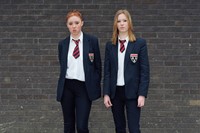As her new exhibition Night Watching and Pictures from the Archive opens in New York, Rineke Dijkstra talks about the importance of casting in her work and drawing inspiration from Rembrandt
Rineke Dijkstra captures her modern-day subjects with the skill of an Old Master, her photography famed for its intimacy and verisimilitude. “You could say a good portrait gives soul to a person”, she tells AnOther. “I always look carefully for moments where people are unguarded”. In a new show at the Marian Goodman Gallery in New York, Night Watching and Pictures from the Archive, the artist revisits her archive and presents never-before-seen works. Focusing on the interpersonal relationships of duos and groups, this show focuses on how we form ourselves through others.
There is a particular charm in Dijkstra’s ability to capture youth, depicting children and teenagers as autonomous individuals, their personalities in a state of flux. Her Beach Portraits (1992-1993) series elevates the youthful subject, with an objective gaze through the medium of portraiture. As unwavering and detailed as her 17th-century influences, such as Rembrandt, Dijkstra calls for careful looking. Intimacy, familiarity and personality are revealed to the careful observer.
Working with a 4x5-inch camera on a tripod, Rineke gives few instructions while photographing. In her 2019 film Night Watching, the artist shadowed school classes and tourists as they reacted to Rembrandts’s The Night Watch (1642), at the Rijksmuseum in Amsterdam. The film traces visitors from all aspects of Dutch society, and follows her signature technique of a straight-on angle and full-frontal pose. Following on from photographic giants such as August Sander and Diane Arbus, this bare-bones approach only emphasises her ability to draw out the complexity of her subjects.
Below, Rineke Dijkstra tells us about her photographic method, delving into her archive, and observing moments of intimacy.
“Two years ago, I started reorganising my negatives and contact prints. It was an interesting process because with 30 years having passed, I noticed all these new relations and possibilities in my own images. I started to build a collection of group and double portraits of people who connected in a certain way. In the 90s, I had focused on single portraits – I now became interested in the relationships between different subjects in one image. Their postures, their expressions, what the similarity of an outfit says or how people distinguish themselves. The best photos, I noticed, always contained a certain contradiction; a kind of tension, both in the figures themselves, or in their relation [to one another].

“In the years 1992 to 1993, I had just started taking beach photos. I didn’t want to focus entirely on one subject, and photographed everyone who seemed interesting to me at that time; individuals, but I also made many double and group portraits. Now that I have returned to my old images, it struck me that very different forms of meaning come into play in the double and group portraits. The posture of the subjects is still important, but by showing several people in one image, elements such as the mutual relationship become much more important: you start to wonder how these people relate to each other, how that relationship becomes visible in the image and on the basis of which visual criteria you as a viewer actually come to your conclusions. Prejudice and assumption, on the behalf of the viewer, comes into play – which I think is interesting.
“The Night Watch is made to impress; it is large and dark, and you really have to take your time to see what is happening. The composition is genius; there is a lot of life in the painting. The lances, which the men hold, largely determine the framework, and keep the group together, emphasised by Rembrandt’s use of light. When the directors of the Rijksmuseum invited me to take a group photo based on The Night Watch, I had to think very carefully. It seemed an impossible task. But then I thought maybe I could make a video. I found it interesting to see how much each child looks at the work – interpreting the painting from his or her own perspective and experience.

“Casting is an important part of my practice. I found a group of girls, about 15 years old, all with the same long straight hair. Then, while observing a group of Japanese businessmen, affiliated with the Japanese Chamber of Commerce in the Netherlands, I immediately felt a powerful hierarchy within the group. They beautifully echoed the dynamics of The Night Watch, without me having to do anything. I wanted to give a very diverse picture of Dutch society in the film; ranging from girls who work at the local supermarket near my studio, a group of retired accountants whom I met at an opening at the Hermitage in Amsterdam, a group of young metalworkers in training, international art students from the Amsterdam Rietveld Academy and expats who worked at Booking.com.”
Night Watching and Pictures from the Archive by Rineke Dijkstra is on show at Marian Goodman Gallery in New York until December 20.






